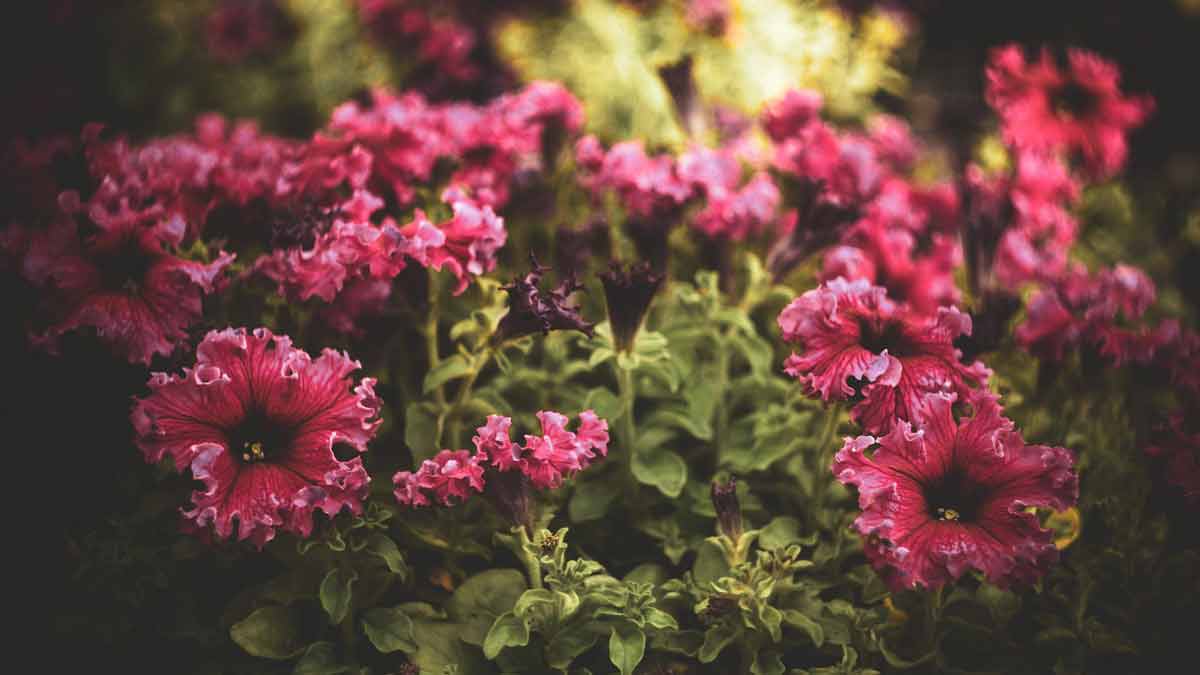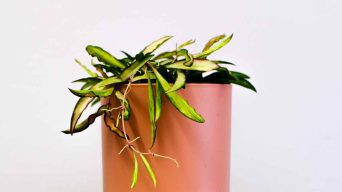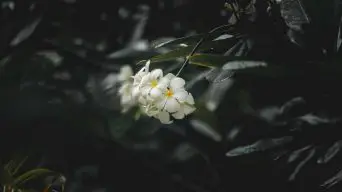Overwatered petunias can exhibit wilting leaves and stems, as well as root rot. This can occur due to a lack of well-draining soil and too frequent watering. Nutrient deficiencies can also be a symptom of overwatering. To prevent this, ensure your petunias have well-draining soil and water only when the soil is dry. Monitor your flowers and roots for signs of overwatering and adjust your watering accordingly.
Petunias are a popular flower worldwide, known for their beauty and ease of care in various colors.
However, even with their low-maintenance reputation, it’s still possible to overwater them.
Signs of overwatering include wilted, yellow leaves, rot at the roots, soggy soil, and drooping flowers.
This guide will provide information on identifying, treating, and preventing overwatering in petunias.
What Are the Risks of Overwatering Petunias?
Overwatering severely damages petunias and can cause several problems, including root rot.
When a plant is overwatered, the roots sit in water and are unable to take up water and nutrients from the soil. This can lead to a number of problems for the plant.
Root Rot
Overwatering causes root rot, one of the most common plant problems.
When the roots of a plant sit in water, they break down and decay, preventing the plant from absorbing water and nutrients. As a result, the petunia leaves turn yellow, wilt, and eventually die.
Additionally, the root rot can spread to the stem, making it weak and causing it to collapse.
Fungal Growth
Fungi can quickly grow in the soil and attack plants when their roots are constantly wet, causing the leaves to turn yellow and wilt. In severe cases, the plant may die.
Common types of fungi that attack overwatered plants include Pythium, Phytophthora, and Verticillium. Each type manifests itself differently, so it’s important to look for specific signs.
Pythium shows as brown or yellow spots on the leaves and wilting, Phytophthora shows as brown or black spots on the leaves and wilting, and Verticillium shows as yellow or white spots on the leaves and wilting.
To avoid fungal diseases such as Leaf Spot, Powdery Mildew, Downy Mildew, Fusarium Wilt, Damping Off, Root Rot, and Stem Rot, it’s important to take preventive measures.
Bacterial Problems
Overwatering petunias can lead to bacterial problems such as crown rot and Botrytis Blight.
These diseases cause the plant to wilt and die due to the wet conditions that promote bacterial growth.
The bacteria can gain access to the plant through the roots or by splashing onto the leaves from the soil. The rapid spread of the bacteria can result in severe damage to the plant.
Pest Infestations
Pests, such as aphids, mealybugs, whiteflies, and spider mites, commonly infest petunia plants that have been overwatered.
These pests weaken the petunias’ leaves, causing them to become yellow and droop. In extreme cases, the infestation can lead to the plant’s death.
Overwatering weakens the plant’s natural defenses and stresses them out, making them vulnerable to pests.
When petunias do not receive enough water, their leaves may fade, wilt or turn yellow due to too much moisture in the root systems. This creates an environment where pests can easily gather and feed on the foliage.
How Does Overwatering a Petunia Occur?
Preventing overwatering begins by understanding how it occurs. Factors that may contribute to overwatering include:
Inadequate Drainage
Inadequate drainage is one of the primary culprits behind overwatering.
If the soil’s structure is too dense or the pot containing the plant doesn’t have enough drainage holes, this can cause water to pool on top and soak into the roots, leading to a plant being overwatered.
To avoid this issue, it’s essential that a pot has good drainage capabilities, meaning an abundance of drainage holes plus well-draining soil. This allows excess water to escape rather than stay in one area and saturate the roots of a plant.
Improper Watering Techniques
Proper watering techniques are essential for preventing overwatering.
Instead of overwatering plants, it’s important to ensure that you water them only when necessary and for the correct amount of time. This requires monitoring the soil to make sure it is kept moist without being overly wet.
Additionally, plenty of drainage should be provided for excess water to escape quickly.
Also, if possible, use a watering method that provides an even distribution of moisture throughout the soil, such as drip irrigation or soaker hoses.
Climate
In humid climates, petunias are especially prone to becoming overwatered – and it’s not just because of the moist air.
High levels of rainfall can also lead to excessive watering of plants, causing many issues.
If you live in a humid area, it’s important to be aware that plants such as petunias might need less water than you’d expect, and also keep an eye on the forecast so that you can adjust your watering schedule accordingly.
Watering Schedule
Rather than sticking to a fixed schedule, it is much more effective to water your plants when they truly require it.
This is especially important during times of changing weather, as this can have a significant impact on the amount of water needed by plants.
Overwatering is often caused by giving too much water on a regular basis without taking into account the actual needs of the plant.
To avoid overwatering, check the soil for moisture before watering and adjust accordingly. If necessary, use a trowel or other tool to gently probe the soil and determine if the roots are still moist.
Hard Water
Hard water is a common cause of overwatering in plants.
It contains a higher concentration of minerals than soft water, which can lead to the accumulation of minerals in the soil around a plant’s roots.
This prevents the plant from absorbing moisture properly, causing it to become overwatered even when watering is done correctly.
If a plant is exposed too often to hard water, it can eventually result in dying or wilting due to a lack of proper hydration.
Pot Size
The pot size you choose for your petunias can have a dramatic effect on whether the plant becomes overwatered or not.
If you opt for a pot that is too small, the roots will become cramped and unable to absorb all the water being provided.
This can lead to an excessive amount of moisture in the soil, even if you are following proper watering guidelines.
To avoid this issue, it is important to select a pot that is adequately sized for the plant’s needs.
The right size will allow the roots enough room to spread out and absorb the correct amount of water, ensuring that your petunias thrive without becoming overwatered.
How To Tell If Your Petunias Are Overwatered?
To prevent overwatering, actively identify the signs of overwatering in petunia plants and take corrective action.
Recognize the difference between overwatered and underwatered petunias as they exhibit distinct symptoms.
Signs of Overwatered Petunias
Identify overwatered petunias by looking for the following signs:
Wet or Soggy Soil
The most evident symptom of overwatering is moist or soggy soil. If the potting soil is persistently wet or soggy, it’s an indication that the plant has been given too much water.
This is particularly noticeable in pots which don’t have drainage holes and in soil that is slow to drain. The potting soil could be damp, darker in color, and feel squishy when touched.
A great way to determine if the soil is overly saturated is to insert your finger into the soil up to the first knuckle; if it feels wet, then overwatering has taken place.
Yellow or Brown Leaves
If the leaves of your petunia plant are turning yellow or brown, this is a sure sign that it’s being overwatered.
These plants often show signs of distress, including wilting and discolored foliage, as well as soggy and mushy textures in their leaves.
If these warning signals are visible, it is essential to take immediate measures to save the plant before it is too late. Doing nothing can cause the plant to perish prematurely.
Drooping or Wilting Leaves
Drooping or wilting leaves are a tell-tale sign of overwatering in petunia plants. This occurs when the plant isn’t receiving sufficient hydration, and its roots cannot absorb water as needed.
As an effect, the leaves start to hang limply instead of standing upright as they normally should.
Overwatering can also cause the plant’s roots to become waterlogged, making it even more difficult for the petunia to take up water from the soil.
When a petunia is overwatered, drooping leaves are one of the first visible signs that something is wrong with its watering routine.
Slow Growth
If your petunia plant is receiving too much water, it won’t be able to grow at its normal rate. This is due to excessive water saturating the soil and preventing the roots from absorbing the needed nutrients for growth.
When this happens, you will notice that your plant’s progress has slowed down and may not even reach its typical size.
Mold or Mildew
Mold and mildew can be a clear indicator of overwatering in plants.
When the conditions are humid and wet, mold and mildew can quickly take hold of plants such as petunia, making them vulnerable to damage.
If you spot any signs of mold or mildew on the leaves or stems of your petunias, it is important to take corrective action without delay.
Overwatering the plant can create an ideal environment for fungal growth which will lead to discoloration, leaf and stem rot, wilting leaves, and even death.
To prevent this from happening, it is important to monitor soil moisture levels carefully.
Soft or Hollow Stems
If your petunia plant has soft or hollow stems, it is a clear indication of overwatering.
Signs of root rot, which can be fatal to the plant, may have already begun to appear.
Root rot occurs when the roots have been sitting in too much water for too long and cannot absorb any more moisture.
It causes a breakdown of the roots and surrounding tissue, resulting in wilting leaves, yellowing foliage, stunted growth, and eventual death of the plant.
To prevent further damage, corrective action must be taken immediately upon noticing these signs by reducing the amount of water being applied and removing any excess from the soil around the roots.
Fungus Gnats
Fungus gnats are small, dark-colored insects that can cause significant damage to your petunia plant if they are present.
These pests thrive in humid and wet conditions, so they may be attracted to petunia plants with too much watering.
Identifying a fungus gnat infestation early on is key to preventing serious damage, as they love to feed on the roots of your plants.
These minute creatures measure no more than 1/16 inch in length and have light-colored wings that make them look almost transparent.
They are often seen hovering near the soil of the petunia plant or flying around the flowers and leaves.
If left unchecked, fungus gnats can create significant damage, even leading to plant death due to their voracious appetite for the roots of plants.
How To Save an Overwatered Petunia Plant?
Save your overwatered petunia plant by taking the following actions:
1. Check the Soil
The first step to assess the health of a plant is to inspect the soil. If the soil is excessively wet or soggy, it could be an indication that the plant has been overwatered.
To save an over-watered plant, it’s important to be patient and allow the soil to dry out completely. This process could take a few days, so being patient is key.
During this time, it’s essential not to water the plant until it has fully recovered from being overwatered.
2. Reduce Watering
Once the soil has dried out, it is important to adjust your watering routine. Water your petunias only when the soil’s surface has become dry to the touch.
This means that you should wait until it is no longer damp and can easily be fluffed with your fingers.
When you do water, be sure to do so deeply, allowing the roots to absorb as much moisture as they need.
Depending on their environment and other factors, petunias typically require watering about once a week for optimal health.
During especially hot and dry weather or if the plant was recently transplanted, you may need to increase watering frequency slightly.
3. Improve Drainage
Watering your plants is an important part of their care, but it’s possible to overdo it.
To counteract overwatering and improve drainage, mix in some perlite or sand with the potting soil. This helps to keep the soil from becoming too compact and creating puddles of water that can suffocate plant roots.
Additionally, make sure that the pot you are using has good drainage holes at the bottom so that any excess water can easily escape.
If you’re still having problems, consider using a pot with feet to elevate it off the ground and allow for even better drainage.
4. Repot the Plant
Repotting a plant that has been overwatered is an important step in caring for it. To do this, you must first carefully remove the plant from its pot and place it in a new pot with drainage holes.
Fill the new pot with a well-draining soil mix, making sure that the area around the roots is completely covered.
After repotting your plant, allow it to remain undisturbed for several days so it can adjust to its new environment.
5. Remove Affected Roots
Carefully remove your plant from its pot and examine the roots.
You may need to cut off any that appear brown or black, using a sharp knife. Make sure to cut away only affected roots, as healthy ones are essential for the plant’s growth.
If you notice lots of overwatered roots, this can be an indication of root rot, which can be caused by excessive water or poor drainage in the soil.
6. Cut Back the Plant
Remove any wilted or dead flowers, and yellow or brown leaves from your plant if it is overwatered. This will help the plant to direct its energy into producing new growth and flourishing.
If you are unsure which leaves are dead or wilting, you can perform a simple test by lightly tugging at the leaf with your finger. If it comes off easily, it is likely not providing much benefit and should be removed.
7. Cut Back on Fertilizer
When it comes to overwatering your plant, it is important to reduce fertilizer usage.
If the plant has been overexposed to water, refrain from fertilizing until it recovers. Once the signs of recovery appear, you can provide the necessary nutrients during its growing season.
To ensure your plant’s well-being, opt for a gentle approach when fertilizing – gradually increasing the dosage over time as opposed to sudden changes in quantity.
8. Place the Plant in a Bright Location
Positioning the petunia in an area that receives at least six hours of direct sunlight daily is key for optimal growth and recovery after taking corrective action.
To ensure the plant receives adequate light, it should be situated in a south-facing window or in an outdoor space where it can get direct rays from the sun.
Petunias thrive when they are bathed in bright, natural light and do not require artificial light sources.
9. Be Patient
It can take several weeks for your plant to overcome overwatering, so be patient.
To ensure that it is on the mend, look out for signs of new growth.
You will want to check the soil regularly and adjust your watering habits accordingly.
How To Prevent Overwatering Petunias
Watering your petunia plant can be easy and stress-free when done correctly.
To ensure you don’t overwater the plant, you should only water it when the soil is dry. To check this, stick your finger in the soil – if it feels dry then it’s time to provide some moisture.
The best way to ensure a well-draining potting mix is achieved is by adding perlite or sand to regular potting soil. This will allow water to flow through the soil more easily, reducing the risk of overwatering.
It’s also important that you choose a pot with drainage holes to prevent root rot and other issues that can arise due to excess moisture.
Finally, make sure your petunia has plenty of sunlight as they need at least six hours each day; placing them in an area of your home that receives ample natural light will help them thrive.
Following these simple steps, you can be confident that your petunia isn’t being watered too often and can remain healthy and vibrant for years to come.
Final Thoughts
Experience the reward of growing petunias, but beware of the common problem of overwatering, as it can lead to severe issues.
To prevent overwatering, ensure proper care, including good drainage and watering schedules. If you suspect your petunias are overwatered, take immediate action to correct the problem.
By identifying the signs of overwatering and taking preventive measures, you can keep your petunias healthy and beautiful throughout the season.
With proper care, your petunias will thrive and offer you beautiful blooms all season long.







